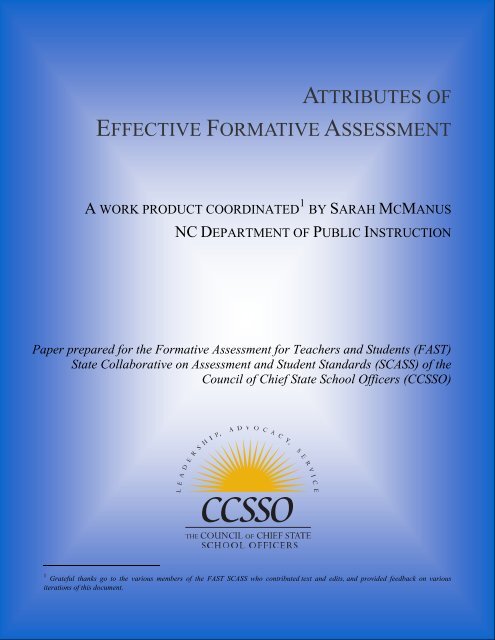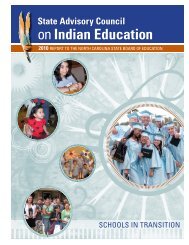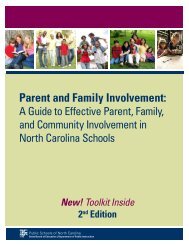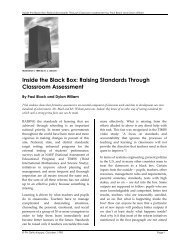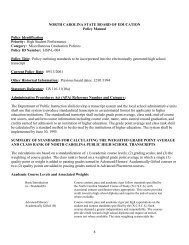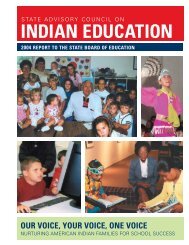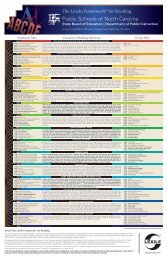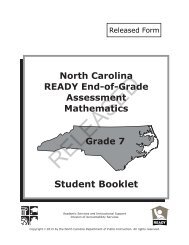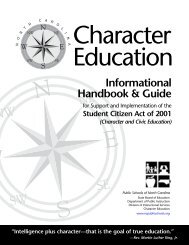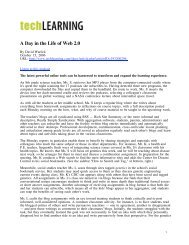Attributes of Effective Formative Assessment - The Council of Chief ...
Attributes of Effective Formative Assessment - The Council of Chief ...
Attributes of Effective Formative Assessment - The Council of Chief ...
Create successful ePaper yourself
Turn your PDF publications into a flip-book with our unique Google optimized e-Paper software.
ATTRIBUTES OF<br />
EFFECTIVE FORMATIVE ASSESSMENT<br />
A WORK PRODUCT COORDINATED 1 BY SARAH MCMANUS<br />
NC DEPARTMENT OF PUBLIC INSTRUCTION<br />
Paper prepared for the <strong>Formative</strong> <strong>Assessment</strong> for Teachers and Students (FAST)<br />
State Collaborative on <strong>Assessment</strong> and Student Standards (SCASS) <strong>of</strong> the<br />
<strong>Council</strong> <strong>of</strong> <strong>Chief</strong> State School Officers (CCSSO)<br />
1 Grateful thanks go to the various members <strong>of</strong> the FAST SCASS who contributed text and edits, and provided feedback on various<br />
iterations <strong>of</strong> this document.
THE COUNCIL OF CHIEF STATE SCHOOL OFFICERS<br />
<strong>The</strong> <strong>Council</strong> <strong>of</strong> <strong>Chief</strong> State School Officers (CCSSO) is a nonpartisan, nationwide, nonpr<strong>of</strong>it organization <strong>of</strong> public <strong>of</strong>ficials who head<br />
departments <strong>of</strong> elementary and secondary education in the states, the District <strong>of</strong> Columbia, the Department <strong>of</strong> Defense Education Activity,<br />
and five U.S. extra-state jurisdictions. CCSSO provides leadership, advocacy, and technical assistance on major educational issues. <strong>The</strong><br />
<strong>Council</strong> seeks member consensus on major educational issues and expresses their views to civic and pr<strong>of</strong>essional organizations, federal<br />
agencies, Congress, and the public.<br />
<strong>Formative</strong> <strong>Assessment</strong> for Students and Teachers<br />
State Collaborative on <strong>Assessment</strong> and Student Standards<br />
<strong>The</strong> <strong>Council</strong>’s State Collaborative on <strong>Assessment</strong> and Student Standards (SCASS) strives to provide leadership, advocacy and service in<br />
creating and supporting effective collaborative partnerships through the collective experience and knowledge <strong>of</strong> state education personnel<br />
to develop and implement high standards and valid assessment systems that maximize educational achievement for all children.<br />
COUNCIL OF CHIEF STATE SCHOOL OFFICERS<br />
Rick Melmer (South Dakota), President<br />
Elizabeth Burmaster (Wisconsin), Past President<br />
T. Kenneth James (Arkansas), President-Elect<br />
Gene Wilhoit, Executive Director<br />
John Tanner, Director Center for Innovative Measures<br />
Douglas Rindone and Duncan MacQuarrie, Co-Coordinators, FAST SCASS<br />
<strong>Council</strong> <strong>of</strong> <strong>Chief</strong> State School Officers<br />
One Massachusetts Avenue, NW, Suite 700<br />
Washington, DC 20001-1431<br />
Phone (202) 336-7000<br />
Fax (202) 408-8072<br />
www.ccsso.org<br />
Copyright © 2008 by the <strong>Council</strong> <strong>of</strong> <strong>Chief</strong> State School Officers, Washington, DC<br />
All rights reserved.
ATTRIBUTES OF EFFECTIVE FORMATIVE ASSESSMENT<br />
A work product coordinated by Sarah McManus, NC Department <strong>of</strong> Public<br />
Instruction, for the <strong>Formative</strong> <strong>Assessment</strong> for Students and Teachers (FAST) Collaborative<br />
Background <strong>of</strong> a Definition<br />
<strong>The</strong>re has been substantial interest in formative<br />
assessment among U.S. educators during recent years.<br />
Increasing numbers <strong>of</strong> educators regard formative<br />
assessment as a way not only to improve student learning,<br />
but also to increase student scores on significant<br />
achievement examinations. To promote the use <strong>of</strong><br />
formative assessment, the <strong>Council</strong> <strong>of</strong> <strong>Chief</strong> State School<br />
Officers (CCSSO) created a national initiative. <strong>The</strong><br />
initiative formally began in January 2006, when CCSSO<br />
formed the <strong>Formative</strong> <strong>Assessment</strong> (FA) Advisory Group<br />
consisting <strong>of</strong> measurement and education researchers<br />
including Jim Popham, Lorrie Shepard, Rick Stiggins, and<br />
Dylan Wiliam and state agency leaders from across the<br />
nation. (A complete list <strong>of</strong> FA Advisory Group members<br />
is at end <strong>of</strong> document.)<br />
CCSSO also formed a new State Collaborative on<br />
<strong>Assessment</strong> and Student Standards (SCASS) to<br />
implement the vision <strong>of</strong> the FA Advisory Group. <strong>The</strong> first<br />
challenge for the <strong>Formative</strong> <strong>Assessment</strong> for Students and<br />
Teachers (FAST) SCASS was to work with the FA<br />
Advisory Group to review the various definitions <strong>of</strong><br />
formative assessment and related research. <strong>The</strong> FA<br />
Advisory Group and FAST SCASS devoted substantial<br />
effort to clarify the meaning <strong>of</strong> “formative assessment,”<br />
based on current literature, and determine how formative<br />
assessment may best be used by the nation’s educators.<br />
In October 2006, FAST SCASS educators<br />
representing approximately 25 states agreed on the<br />
definition <strong>of</strong> formative assessment presented in this<br />
document and it was subsequently approved by the FA<br />
Advisory Group. In the year following, the FAST SCASS<br />
and FA Advisory Group isolated the attributes that, based<br />
on the research and current literature, would render<br />
formative assessment most effective. This document<br />
presents the definition <strong>of</strong> formative assessment and<br />
identifies and explains the five attributes <strong>of</strong> effective<br />
formative assessment.<br />
<strong>The</strong> Definition <strong>of</strong> <strong>Formative</strong> <strong>Assessment</strong><br />
During the October 2006, inaugural FAST SCASS<br />
meeting in Austin, Texas, the following definition <strong>of</strong><br />
formative assessment was adopted, without dissent:<br />
<strong>Formative</strong> assessment is a process used by<br />
teachers and students during instruction that<br />
provides feedback to adjust ongoing teaching<br />
and learning to improve students’ achievement<br />
<strong>of</strong> intended instructional outcomes.<br />
A Closer Look at the Definition<br />
<strong>The</strong> primary purpose <strong>of</strong> the formative assessment<br />
process, as conceived in this definition, is to provide<br />
evidence that is used by teachers and students to inform<br />
instruction and learning during the teaching/learning<br />
process. <strong>Effective</strong> formative assessment involves<br />
collecting evidence about how student learning is<br />
progressing during the course <strong>of</strong> instruction so that<br />
necessary instructional adjustments can be made to close<br />
the gap between students’ current understanding and the<br />
desired goals. <strong>Formative</strong> assessment is not an adjunct to<br />
teaching but, rather, integrated into instruction and<br />
learning with teachers and students receiving frequent<br />
feedback.<br />
One key feature <strong>of</strong> this definition is its requirement<br />
that formative assessment be regarded as a process rather<br />
than a particular kind <strong>of</strong> assessment. In other words, there<br />
is no such thing as “a formative test.” Instead, there are a<br />
number <strong>of</strong> formative assessment strategies that can be<br />
implemented during classroom instruction. <strong>The</strong>se range<br />
from informal observations and conversations to<br />
purposefully planned instructionally embedded techniques<br />
designed to elicit evidence <strong>of</strong> student learning to inform<br />
and adjust instruction.<br />
A second important part <strong>of</strong> the definition is its<br />
unequivocal requirement that the formative assessment<br />
process involve both teachers and students. <strong>The</strong> students<br />
must be actively involved in the systematic process<br />
intended to improve their learning. <strong>The</strong> process requires<br />
the teacher to share learning goals with students and<br />
provide opportunities for students to monitor their<br />
ongoing progress.<br />
THE COUNCIL OF CHIEF STATE SCHOOL OFFICERS<br />
3<br />
THE FAST SCASS • FORMATIVE ASSESSMENT FOR TEACHERS AND LEARNERS
THE ATTRIBUTES OF EFFECTIVE FORMATIVE ASSESSMENT<br />
<strong>Attributes</strong><br />
<strong>The</strong>re are five attributes that have been identified from the literature as critical features <strong>of</strong> effective formative<br />
assessment. No one <strong>of</strong> the following attributes should be regarded as a sine qua non, that is, an attribute without which the<br />
assessment would not be formative.<br />
1.<br />
Learning Progressions: Learning progressions should<br />
clearly articulate the sub-goals <strong>of</strong> the ultimate learning<br />
goal.<br />
Learning progressions describe how concepts and<br />
skills build in a domain, and show the trajectory <strong>of</strong><br />
learning along which students are expected to progress.<br />
From a learning progression teachers have the big picture<br />
<strong>of</strong> what students need to learn, as well as sufficient detail<br />
for planning instruction to meet short-term goals. <strong>The</strong>y<br />
are able to connect formative assessment opportunities to<br />
the short-term goals to keep track <strong>of</strong> how well their<br />
students’ learning is moving forward.<br />
For example, at the earliest stages <strong>of</strong> a progression<br />
for historical inquiry students must learn how to<br />
investigate the past from a range <strong>of</strong> sources <strong>of</strong><br />
information, (e.g., stories, eyewitness accounts, pictures,<br />
photographs, artifacts, historic buildings, museums,<br />
galleries, and technology-based sources). Students build<br />
on this learning in later stages <strong>of</strong> the progression to<br />
develop an understanding that people represent and<br />
interpret the past in different ways (e.g., through pictures,<br />
plays, films, reconstructions, museum displays, and<br />
fiction and nonfiction accounts), and that the<br />
interpretations reflect the intentions <strong>of</strong> those who make<br />
them (e.g., writers, archaeologists, historians, and<br />
filmmakers). A goal for students at each level <strong>of</strong> the<br />
progression would be to investigate a set <strong>of</strong> artifacts in<br />
increasingly sophisticated ways to extract information<br />
about a particular period or event in history. Not only<br />
would such investigations support the students’<br />
development <strong>of</strong> historical reasoning, they would also<br />
provide evidence <strong>of</strong> the students’ ability to reason in<br />
increasingly complex ways. This involves moving from<br />
the early stages <strong>of</strong> reasoning based on simple observation<br />
to the more complex stages based on indirect observation<br />
and the synthesis <strong>of</strong> multiple sources <strong>of</strong> information.<br />
Using the evidence elicited from such tasks connected to<br />
the goals <strong>of</strong> the progression, a teacher could identify the<br />
“just right gap” – a growth point in learning that involves<br />
a step that is neither too large nor too small – and make<br />
adjustments to instruction accordingly.<br />
2.<br />
Learning Goals and Criteria for Success: Learning<br />
goals and criteria for success should be clearly identified<br />
and communicated to students.<br />
Because the formative assessment process helps<br />
students achieve intended learning outcomes based on<br />
explicit learning progressions, teachers must first identify<br />
and then communicate the instructional goal to students.<br />
In addition to communicating the nature <strong>of</strong> the<br />
instructional goal, teachers must provide the criteria by<br />
which learning will be assessed so that students will know<br />
whether they are successfully progressing toward the<br />
goal. This information should be communicated using<br />
language readily understood by students, and may be<br />
accompanied by realistic examples <strong>of</strong> those that meet and<br />
do not meet the criteria.<br />
For example, suppose the goal <strong>of</strong> a social studies<br />
instructional unit was to have students “prepare a written<br />
critique <strong>of</strong> the quality <strong>of</strong> arguments in political essays in a<br />
local newspaper’s editorial pages.” <strong>The</strong> teacher might first<br />
<strong>of</strong>fer students a paraphrased version <strong>of</strong> that goal such as,<br />
“You will be able to judge the strengths and weaknesses<br />
<strong>of</strong> arguments in the editorials you find in our daily<br />
newspapers.” <strong>The</strong> teacher would discuss the criteria for<br />
evaluating arguments and then provide several examples<br />
<strong>of</strong> critiques <strong>of</strong> political essays. This will provide students<br />
with a reasonably clear idea <strong>of</strong> the analytic skills they are<br />
to develop and also provide them with the tools required<br />
to assess their own written analyses.<br />
3.<br />
Descriptive Feedback: Students should be provided with<br />
evidence-based feedback that is linked to the intended<br />
instructional outcomes and criteria for success.<br />
Descriptive feedback should be about the particular<br />
qualities <strong>of</strong> student learning with discussion or<br />
suggestions about what the student can do to improve. It<br />
should avoid comparisons with other pupils. Specific,<br />
timely feedback should be based on the learning goal and<br />
criteria for success. It should help the student answer<br />
three basic questions: Where am I going? Where am I<br />
now? How can I close the gap?<br />
For example, in an eighth grade writing class the<br />
students are learning how to construct an argument. <strong>The</strong>y<br />
are focusing specifically on speech-writing and have<br />
examined several effective speeches, both from prominent<br />
speech-makers in history and from previous years’ eighth<br />
grade students. In this particular lesson, students have<br />
been asked to write an opening paragraph to their speech<br />
with the success criteria <strong>of</strong> introducing their topic in a<br />
way that engages the audience. <strong>The</strong> feedback the teacher<br />
gives to one student is, “<strong>The</strong> opening paragraph does not<br />
capture the audience’s attention because it does not<br />
clearly state what the speech is about. However, the<br />
opening sentence <strong>of</strong> the second paragraph states your<br />
position with an effective contrast. What can you do to<br />
improve or strengthen your opening paragraph?” With<br />
this kind <strong>of</strong> descriptive feedback and collaboration, the<br />
teacher clarifies the goal for the student, provides specific<br />
information about where the student is in relation to<br />
meeting the criteria, and <strong>of</strong>fers enough substantive<br />
THE COUNCIL OF CHIEF STATE SCHOOL OFFICERS<br />
4<br />
THE FAST SCASS • FORMATIVE ASSESSMENT FOR TEACHERS AND LEARNERS
information to allow the student an opportunity to identify<br />
ways to move learning forward.<br />
Similarly, in a sixth grade math class students<br />
working in groups have been asked to review an example<br />
<strong>of</strong> the steps a student from a previous year took to solve a<br />
problem. <strong>The</strong>y must decide if the work is correct or<br />
incorrect and provide an explanation for their view. <strong>The</strong><br />
success criterion that the teacher gives them is, “Include<br />
any properties or rules that may apply in your<br />
explanation.” When the groups report back after their<br />
discussions, the teacher listens for the rules or properties<br />
in the explanations, and this becomes the focus <strong>of</strong> her<br />
feedback. To one group she says, “Your explanation<br />
shows me that you understand that the steps the student<br />
took to solve the problem were incorrect. Remember the<br />
success criterion. You must also relate your explanation<br />
to one <strong>of</strong> the properties we have been discussing in class<br />
to indicate the reason the steps were incorrect.” Again, the<br />
students know the goal, where their response differed<br />
from the criteria, and how they can improve their<br />
explanations.<br />
4.<br />
Self- and Peer-<strong>Assessment</strong>: Both self- and peerassessment<br />
are important for providing students an<br />
opportunity to think meta-cognitively about their<br />
learning.<br />
<strong>Formative</strong> assessment is a process that directly<br />
engages both teachers and students. In addition to teacher<br />
feedback, when students and their peers are involved<br />
there are many more opportunities to share and receive<br />
feedback. Helping students think meta-cognitively about<br />
their own learning fosters the idea that learning is their<br />
responsibility and that they can take an active role in<br />
planning, monitoring, and evaluating their own progress.<br />
To support both self- and peer-assessment, the teacher<br />
must provide structure and support so students learn to be<br />
reflective <strong>of</strong> their own work and that <strong>of</strong> their peers,<br />
allowing them to provide meaningful and constructive<br />
feedback.<br />
In self-assessment, students reflect on and monitor<br />
their learning using clearly explicated criteria for success.<br />
In peer-assessment, students analyze each others’ work<br />
using guidelines or rubrics and provide descriptive<br />
feedback that supports continued improvement. For<br />
example, students can work in pairs to review each<br />
other’s work to give feedback. A teacher needs to have<br />
modeled good feedback with students and talked about<br />
what acceptable and unacceptable comments look like in<br />
order to have created a safe learning environment.<br />
Students can use a rubric to provide feedback to a peer by<br />
articulating reasons why a piece <strong>of</strong> work is at one level<br />
and discussing how it could be improved to move it to the<br />
next level. Alternatively, feedback could be given using a<br />
format such as “two stars and a wish,” which provides a<br />
structure for a student to identify two aspects <strong>of</strong> the work<br />
that are particularly strong (stars) and one aspect the peer<br />
might improve (a wish). Students then need time to reflect<br />
on the feedback they have received to make changes or<br />
improvements. In addition, students can be encouraged to<br />
be self-reflective by thinking about their own work based<br />
on what they learned from giving feedback to others. A<br />
further benefit <strong>of</strong> providing feedback to a peer is that it<br />
can help deepen the student’s own learning. However,<br />
student- and peer-assessment should not be used in the<br />
formal grading process.<br />
5.<br />
Collaboration: A classroom culture in which teachers<br />
and students are partners in learning should be<br />
established.<br />
Sharing learning goals and criteria for success with<br />
students, supporting students as they monitor and take<br />
responsibility for their own learning, helping students to<br />
provide constructive feedback to each other, and<br />
involving students in decisions about how to move<br />
learning forward are illustrations <strong>of</strong> students and teachers<br />
working together in the teaching and learning process.<br />
However, for students to be actively and successfully<br />
involved in their own learning, they must feel that they<br />
are bona fide partners in the learning process. This feeling<br />
is dependent on a classroom culture characterized by a<br />
sense <strong>of</strong> trust between and among students and their<br />
teachers; by norms <strong>of</strong> respect, transparency, and<br />
appreciation <strong>of</strong> differences; and by a non-threatening<br />
environment. Creating such a culture requires teachers to<br />
model these behaviors during interactions with students,<br />
to actively teach the classroom norms, and to build the<br />
students’ skills in constructive self- and peer-assessment.<br />
In this type <strong>of</strong> classroom culture, students will more likely<br />
feel they are collaborators with their teacher and peers in<br />
the learning process.<br />
While evidence exists in varying degrees to support<br />
the five attributes presented, there is clearly no one best<br />
way to carry out formative assessment. <strong>The</strong> way these<br />
attributes are implemented depends on the particular<br />
instructional context, the individual teacher, and—<br />
perhaps most importantly—the individual students.<br />
For examples on how to incorporate the five<br />
attributes into practice refer to the document <strong>Formative</strong><br />
<strong>Assessment</strong>: Examples <strong>of</strong> Practice. 2<br />
Suggested Readings<br />
Heritage, M. (February, 2008). Learning Progressions:<br />
Supporting Instruction and <strong>Formative</strong> <strong>Assessment</strong>.<br />
<strong>Council</strong> <strong>of</strong> <strong>Chief</strong> State School Officers: Washington DC.<br />
2 <strong>Formative</strong> <strong>Assessment</strong>: Examples <strong>of</strong> Practice. <strong>Council</strong> <strong>of</strong> <strong>Chief</strong><br />
State School Officers: Washington, DC 2008. A work product<br />
initiated and led by E. Caroline Wylie, ETS, for the <strong>Formative</strong><br />
<strong>Assessment</strong> for Students and Teachers (FAST) Collaborative.<br />
THE COUNCIL OF CHIEF STATE SCHOOL OFFICERS<br />
5<br />
THE FAST SCASS • FORMATIVE ASSESSMENT FOR TEACHERS AND LEARNERS
THE ATTRIBUTES OF EFFECTIVE FORMATIVE ASSESSMENT<br />
CCSSO <strong>Formative</strong> <strong>Assessment</strong> Advisory Group 3<br />
ANNETTE BOHLING, AZ, SR. VICE PRESIDENT OF ACCREDITATION, ADVANCED, ARIZONA STATE UNIVERSITY<br />
WILLIAM BUSHAW, IN, EXECUTIVE DIRECTOR, PHI DELTA KAPPA<br />
DOUG CHRISTENSEN, NE, COMMISSIONER OF EDUCATION, NEBRASKA DEPARTMENT OF EDUCATION<br />
ANGELA FAHERTY, ME DEPUTY ASSOCIATE SUPEINTENDENT, STANDARDS AND ASSESSMENT SECTION, MAINE DEPARTMENT<br />
OF EDUCATION<br />
MARGARET HERITAGE, CA, ASSISTANT DIRECTOR FOR PROFESSIONAL DEVELOPMENT, NATIONAL CENTER FOR RESEARCH ON<br />
EVALUATION, STANDARDS AND STUDENT TESTING, UNIVERSITY OF CALIFORNIA<br />
GERUNDA HUGHES, DC, ASSOCIATE PROFESSOR, CURRICULUM AND INSTRUCTION PROGRAM COORDINATOR, SECONDARY<br />
EDUCATION, HOWARD UNIVERSITY<br />
HENRY JOHNSON, FORMER ASSISTANT SECRETARY FOR ELEMENTARY AND SECONDARY EDUCATION, U.S. DEPARTMENT OF<br />
EDUCAITON<br />
STUART KAHL, NH, PRESIDENT AND CEO, MEASURED PROGRESS<br />
KEN KAY, AZ, PRESIDENT, PARTNERSHIP FOR 21 ST CENTURY SKILLS<br />
SARAH MCMANUS, NC, SECTION CHIEF, TESTING POLICY AND OPERATIONS, NORTH CAROLINA DEPARTMENT OF PUBLIC<br />
INSTRUCTION<br />
BOB NIELSEN, IL, SUPERINTENDENT, BLOOMINGTON, ILLINOIS PUBLIC SCHOOLS<br />
SCOTT NORTON, LA, DIRECTOR, STUDENT STANDARDS & ASSESSMENTS, LOUISIANA DEPARTMENT OF EDUCATION<br />
JIM POPHAM, HI, EMERITUS PROFESSOR, UNIVERSITY OF CALIFORNIA<br />
DORIS REDFIELD, WV, PRESIDENT/CEO, EDVANTIA<br />
WENDY ROBERTS, DE, ASSESSMENT DIRECTOR, ELAWARE DEPARTMENT OF EDUCATION<br />
LORRIE SHEPARD, CO, DEAN, SCHOOL OF EDUCATION, PROFESSOR OF EDUCATION, UNIVERSITY OF COLORADO AT BOULDER<br />
RICK STIGGINS, OR, CEO, ASSESSMENT TRAINING INSTITUTE (AT), ETS<br />
MARTHA THURLOW, MN, PROFESSOR, NATIONAL CENTER ON EDUCATION OUTCOMES, UNIVERSITY OF MINNESOTA<br />
DYLAN WILIAM, UK, DEPUTY DIRECTOR, INSTITUTE OF EDUCATION, UNIVERSITY OF LONDON<br />
3 <strong>The</strong> CCSSO <strong>Formative</strong> <strong>Assessment</strong> Advisory Group was formed in March 2006. This is a list <strong>of</strong> the original members who were<br />
responsible for developing and approving the definition and attributes <strong>of</strong> effective formative assessment.<br />
THE COUNCIL OF CHIEF STATE SCHOOL OFFICERS<br />
6<br />
THE FAST SCASS • FORMATIVE ASSESSMENT FOR TEACHERS AND LEARNERS


